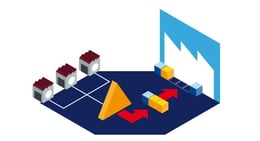What Should Your S&OP Solution Actually Do?
Brian Hoey - November 24, 2020

 Supply and demand represent two of the most basic, foundational business concepts that we have—and yet, getting the two optimally aligned with one another is a challenge even for long-established companies with track records of success. To wit, most manufacturers currently utilize some kind of S&OP (sales and operations planning) process, the complexity of which strongly suggests the complexity of the overarching task of identifying product demand and translating it into appropriate production capacity and capacity utilization.
Supply and demand represent two of the most basic, foundational business concepts that we have—and yet, getting the two optimally aligned with one another is a challenge even for long-established companies with track records of success. To wit, most manufacturers currently utilize some kind of S&OP (sales and operations planning) process, the complexity of which strongly suggests the complexity of the overarching task of identifying product demand and translating it into appropriate production capacity and capacity utilization.
Typically, planners seek a remedy to this inherent complexity in their sales planning solutions. But what should an effective S&OP software module actually do? What features should it have built-in to support businesses that need to transform complex market data and production requirements into real, concrete plans? The answer will vary depending on the exact specifications and details of your business, but there are a handful of features that are worth seeking out:
Forecasting
One of the most important parts of the S&OP process is forecasting customer demand for the coming quarter or year. In other words, your S&OP is only as valuable as the accuracy of your predictions. You can have the world’s most robust planning meetings, but if your vision of future demand misses the mark by a large percentage, you’re going to be stuck with costly and unnecessary capital commitment or large-scale shortages. That’s why the right S&OP solution should produce forecasts that are as sophisticated as possible. This might look like AI-integration that turns your operational data into structured insights, or advanced predictive analytics algorithms designed to go beyond historical data in creating predictions. Since this sets the baseline for your ability to plan effectively, it’s one of the most important functions that your planning software should have.
Detailed Planning
Once you have a reasonably accurate forecast in tow, you can begin the process of actually matching up demand and capacity. This, of course, requires gaining a thorough understanding of what your capacity actually is—which, in turn, requires understanding your production flows down to the parts level. Ideally, your S&OP software would be able to provide visualizations of how different hypothetical orders (i.e. expected demand) will translate into individual production sequences and BOMs (bills of materials). In this way, you can combine your high-level product planning with the kind of nitty-gritty details you’ll need to secure parts from your suppliers at favorable prices, manage your inventory, etc. With this level of detail, it’s easy to begin extending the benefits of visibility to other touchpoints beyond the production line, e.g. logistics planning.
Order Generation
When we said above that you should be able to understand your capacity in terms of hypothetical orders, we weren’t being rhetorical. A truly sophisticated S&OP system will give you the ability to create orders before customers have actually made them—then populate them with actual orders as they come into existence—meaning that you’re able to take a proactive approach to the entire value chain operation. Again, this is something that only works if your forecasts are highly accurate. But if they are, you can essentially model expected consumer behavior on the level of individual planned orders (with real production dates and schedules). This means that when the customer orders do arrive, you can simply insert them into your existing production planning schema, making only minor alterations to your overarching plans as real demand levels begin to reveal themselves, rather than scrambling to establish schedules from scratch. Not only does this help you reduce your processing time, it also makes it much easier for you to visualize your capacity in terms of actual production sequences and ratios, giving you a clearer picture of whether you need to make any changes or adjustments in order to keep your medium-term plans on track across the entire supply chain.
Dashboards and Reporting
Of course, to really gain an advantage from centralized information, or from AI-powered analyses, you need to be able to access that information in a usable, user-friendly way. That means that features like monitoring and reporting—line items that might seem like afterthoughts compared to the larger functional areas of the software—are actually mission critical for getting maximum value out of your technology and your S&OP meetings. In as close as possible to real-time, you need to be able to see what’s happening across your supply chain, how relevant demand indicators are changing and trending, how your AI algorithms are interpreting the new data, and how your performance compares to your expectations. Your dashboards should give you the ability to visualize your relevant planning parameters and forecasting, while giving you the ability to simulate adjustments to your plans in order to estimate the effects. Ideally, your reporting and dashboards are integrated into your IT environment in such a way as to make it easy for stakeholders anywhere on the value chain to quickly gain an understanding of what’s happening within your S&OP process.
Interoperability
We’ve talked a lot about data so far in this article, and you might be wondering where, exactly, it’s all supposed to be coming from. To answer that question, we have to think beyond the strict boundaries of the S&OP process. Ultimately, the accuracy of your forecasts and your production plans depends on your ability to take in data from numerous touchpoints on the value chain, and the ease of integration with other IT solutions will determine whether you wind up with true end-to-end visibility or find yourself mired in data silos.
In order to help empower true visibility, your S&OP solution should be able to easily connect and interoperate with, for instance, your demand-capacity planning solution, your order slotting and scheduling software, and other elements of your software architecture. Once you’re in a position to share data and plans between these different nodes, you can ensure the accuracy of your data, and thereby increase the accuracy of your forecasts. From there, you can work across departments to stay dynamic in your capacity management—all in the pursuit of more agile and efficient order fulfillment.
LATEST POSTS
- Understand Circular Economy in The Manufacturing Industry
- How Can Industry 4.0 IT Integration Be Achieved Smoothly?
- The Significance of Order Sequencing in Discrete Manufacturing
- How to improve your Supply Chain Management: The Power of Control Towers
- Optimizing Human Resource Scheduling in Manufacturing: A Technological Approach



